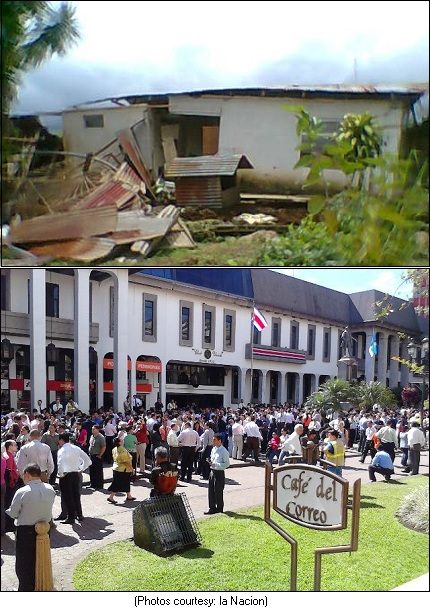
|
|

|
|
| April 24, 2024 |
|
Two dead, 20 injured as major earthquake damages Costa Rica coast, Red Cross says 
Two people died, one of them from a heart attack, when a major earthquake hit northwestern Costa Rica on Wednesday, the Red Cross said. At least 20 people were injured and two others were missing, but the Red Cross said those numbers could rise as damage assessment teams reached more areas.
The quake, initially rated at magnitude 7.9 but then revised by the the U.S. Geological Survey to 7.6, struck at 10:42 a.m. ET at a depth of about 25 miles about 7 miles southeast of Nicoya. The town of 15,000 people is near the Pacific coast, about 90 miles from the capital, San Jose. Government buildings, including the National Assembly complex in San Jose, were under evacuation orders, the newspaper La Nacion reported. Thousands of youngsters were sent home from school as a precaution against aftershocks. The Pacific Tsunami Warning Center canceled tsunami warnings for Costa Rica, Panama and Nicaragua. A woman from the Pacific coastal town of Carrillo suffered a heart attack during the quake. The woman, who was about 55 years old, died at a hospital in Guanacaste, Eva Camargo, the clinic's director, told the news service Terra. No details on the second person who died were immediately available. Camargo said the hospital was treating at least 20 people for quake-related injuries. Two other people suffered minor injuries at the Hotel Barceló Tambor Beach in Playa Tambor, said Alcides Gonzalez, mayor of the coastal town of Paquera. The nature of their injuries wasn't immediately known, but Gonzalez told La Nacion that the resort hotel was damaged when a pipe collapsed. It couldn't be immediately determined whether the victims were tourists or hotel employees. Costa Rican President Laura Chinchilla Miranda met with the National Emergency Council and the International Committee of the Red Cross later in the morning. In a news conference monitored by NBC News, Chinchilla confirmed that several buildings had been damaged in the capital and called on residents of the western coast to remain calm. Power was out in Puntarenas, capital of the province of the same name, where Monsignor Sanabria Hospital was evacuated for a structural review amid visible signs of damage. A bridge over the Sucio River collapsed in the town of Sarapiqui, local media reported. Some roads were blocked by landslides, and the Red Cross said rescue teams were unable to reach some areas. 'Everybody is crying' The National Volcanological and Seismological Observatory at Universidad Nacional reported more than 60 aftershocks between magnitudes 2 and 4 in the hours after the quake. Jorge Marino Protti, a seismologist with the observatory, said the quake was the caused by subduction between the Cocos and Caribbean tectonic plates. It occurred generally beneath the Nicoya Peninsula, but "you can't specify an exact 'epicenter' because the rupture zone was so wide," Protti said in a briefing. The shaking caused the peninsula to rise about a meter, he said. Victor Suniga, owner of another hotel, the Samara Tree House Inn, told NBC News that the quake was felt "very strongly." "Everyone ran from their businesses and homes into the street," he said. "It was frightening. But there have been no reports of damage. Power was shut down for safety but is now beginning to return." Erin Morris, a college English teacher in San Isidro de Heredia, near San Jose, said, "People are definitely shaken up here." "We were in class when the building started rolling back and forth," Morris, 30, who is from South Carolina, told NBC News by email. "Everyone stopped talking and held still for what seemed like an eternity before we jumped into action and quickly exited the building. "As I walked out of the classroom, I noticed all the buildings out of the window shaking back and forth," she said. "Everything was diagonal and skewed in the frame." Robert Torres, desk manager at the Hotel Rio Tempisque in Nicoya, said the quake was also felt there. "All businesses in the town have shut down for the day and sent their workers home. There was power in the area following the quake, but it has been turned off for safety checks," he told NBC News. He said he was unaware of any damage in Nicoya. There were local media reports of serious damage to houses in the Santa Cruz area. The USGS said that "overall, the population in this region resides in structures that are vulnerable to earthquake shaking, though some resistant structures exist." "The predominant vulnerable building types are adobe block and mud wall construction," it said. (Source: NBC News) Story Date: September 6, 2012
|